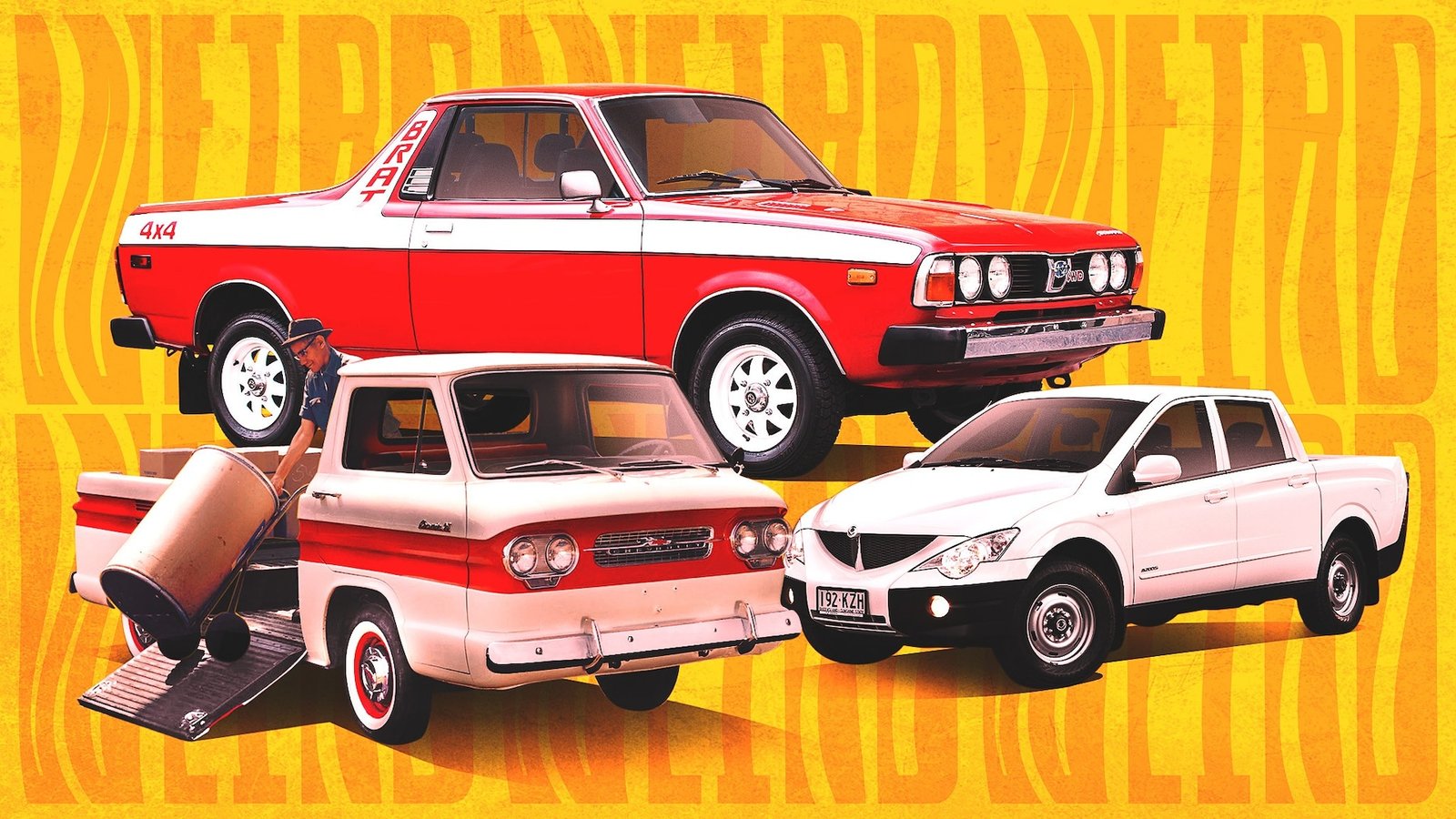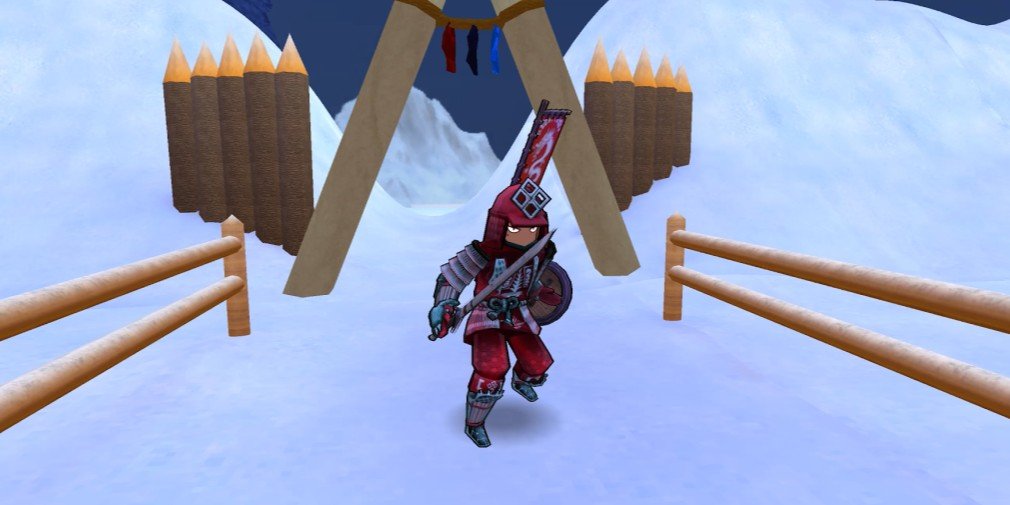Who says the pickup truck has been perfected? Oh wait—the poor sales and dismal receptions of these trucks do.
Aaron GoldWriter
How hard can it be to build a pickup truck? You need a place for people to sit at one end, a bed to load stuff into at the other, a powerplant somewhere and perhaps a trailer hitch. Boom. Done. And yet, in the years—nay, decades—since this most utilitarian form of transportation has been more-or-less perfected, automakers have come up with some inexplicably strange variations. Some were more useful than standard pickups, most a lot less, but all of them were largely rejected by buyers for more traditional pickups. Here are ten of the weirdest pickup trucks that have made it into volume production, for better or worse. (Usually worse.)
1961 Chevrolet Corvair Rampside
A pickup that you load from the side? That was the concept behind the Corvair Rampside, a derivative of the Corvair Greenbriar forward-control van. Since the Corvair platform had the entire powertrain behind the rear axle, Chevrolet was able to drop the center section right to the ground and add a hinged side panel strong enough to serve as a ramp. Out back, where the floor lifted to clear the flat-six engine, the Rampside had a tailgate at conventional truck’s height. Chevy also made a version called the Loadside with a flat-floor bed and underfloor storage bays. Crazy, right, daddy-o?
Actually, it wasn’t an original idea: The Rampvan, like the entire Corvair lineup, was heavily inspired by Volkswagen, which made a pickup version of the Type 2 van, which was imported to the U.S. from 1959 until the Chicken Tax killed it in 1964. Unfortunately, the Corvair-based trucks were not particularly strong sellers. Out of the 1.2 million Corvairs Chevy sold between 1961 and ’64, Chevrolet sold just 17,786 Rampsides and a mere 2,844 Loadsides. The vans did a bit better.
1978 Subaru BRAT
Japanese mini-pickups were all the rage among newly-muscle-car-deprived Americans in the 1970s. Subaru’s American division was eager to get in on that game, but the only trucklets Subaru had were itty-bitty Japanese kei trucks. Given Americans’ reception to the 360 kei sedan, Subaru sure as hell wasn’t going to try that again. Instead, they replaced the back half of a GL wagon with a pickup bed to create the Bi-drive Recreational All-terrain Transporter, otherwise known as the BRAT. The pickup box would have subjected the BRAT to a 25-percent tariff, the so-called “chicken tax” on foreign trucks, so Subaru carpeted the bed and put in two rear-facing jump seats with hang-on handles that looked like they were made from cut-down ski poles. This, believe it or not, was enough to make the BRAT a passenger car in the government’s eyes. Sitting back there while the BRAT was in motion was reportedly as exhilarating as it was dangerous.
The BRAT had at least one unexpected fan: President Ronald Reagan, who was in the White House when the ass-kicking of Detroit by Japanese imports really got into full swing. President Reagan drove a Subaru BRAT—since restored by Subaru—around his Santa Barbara ranch. For obvious reasons he avoided being photographed behind the wheel of his Subaru, through he had no issue posing with his Jeep CJs.
1978 Volkswagen Rabbit Pickup
Subaru wasn’t the only automaker eager to cash in on the mini-truck scene while lacking a proper vehicle with which to do it. Volkswagen’s American arm was also interested in a mini-truck, and prompted Germany to create a Rabbit with a bed where the back end of the body used to be. With its almost-five-and-a-half-foot bed, the Rabbit Pickup had an 1,100-pound payload capacity, and with the optional 1.5 liter diesel under the hood, it could return 50 mpg (with no cargo and careful driving, presumably).
The idea of a front-wheel-drive pickup truck was greeted with some derision; in those pre-internet days, the rumor was that an overly-laden Rabbit pickup was incapable of forward motion, owing to all of the weight being taken off the drive wheels. We’re still waiting for 8mm film evidence to show up on YouTube, but the Rabbit Pickup was good enough to spawn a Chrysler imitation (our next entry), and a version called the Caddy remained in production in South Africa until 2007.
1982 Dodge Rampage
Chrysler’s first-ever front-wheel-drive car—er, two cars, the Dodge Omni and Plymouth Horizon—followed the closely in the VW Rabbit’s tire tracks, so it’s no surprise that when Volkswagen developed a Rabbit-based pickup, Chrysler did the same with the Omnirizon. The Dodge Rampage’s front clip shared the sleeker bodywork of the two-door Omni O24, while the pickup bed was supported by a leaf-spring rear suspension designed specifically for the Rampage. Power came from Chrysler’s newly-introduced K-car star, the home-grown 83-hp 2.2 liter four-cylinder, and the Rampage’s 1,145-pound payload (inclusive of passengers) was better than the 1978 Chevrolet El Camino’s 800-pound capacity.
Most Dodge models had a Plymouth equivalent, and the same was true for the Rampage, at least briefly. For the 1983 model year, Plymouth had its own version of the Rampage called the Scamp, recycling a name once applied to sporty two-door Valiants. The Scamp pickup lasted just one year, and the Rampage only three, but Dodge resurfaced the name on a 2006 pickup concept and is now applying it to a compact pickup sold in South America.
1989 Dodge Dakota Convertible
Chrysler had a real thing for convertibles in the 1980s. The 1982 LeBaron was the first American-made convertible since Caddy dropped the Eldorado in the mid-1970s, and the much-much-better 1987 LeBaron drop-top was an even stronger seller, and its near-twin, the “Chrysler TC by Maserati”, an even weaker one. Dodge even made a convertible version of the Shadow compact, which is sort of the equivalent of making a convertible Nissan Versa today. So why not a convertible pickup truck? Yep, Chrysler did that too, with their innovative mid-size 1989 Dodge Dakota (though, truth be told, convertible pickups weren’t exactly a new idea).
Dodge shipped brand-new Dakota Sports to the American Sunroof Company (ASC), which replaced the roof with a roll bar and a manually-operated convertible top. Amazingly, buyers did not flock to this novel method of open-air cargo hauling: Dodge sold just shy of 3,000 Dakota convertibles for the 1989 model year, just over 900 in 1990, and a mere 9 in 1991. It probably didn’t help that the convertible wasn’t offered with the Dakota’s optional V-8 engine, but more likely this was a case of everyone who wanted a convertible Dakota getting one. Chrysler wouldn’t let the idea die, however; as we write this, you can buy a Jeep Gladiator pickup with a removable roof—and that model’s initial sales surge followed by years of tapering interest sure reminds us of something…
2002 Chevrolet Avalanche
The goal of the new-for-2002 Avalanche was to blend the best of a truck and the best of an SUV in one vehicle. The Avalanche was derived not from the Silverado pickup but from the Suburban SUV; note the lack of a gap between the cab and the bed, which gave the Avalanche’s body more solidity and a smoother ride. What about the tiny 5-foot, 3-inch bed? How useful could that be? That’s where the “Midgate” came in. Cab and bed were divided by a panel that could be folded down along with the rear seats, allowing the Avalanche to carry 4×8 sheets of plywood with the tailgate closed (but the cab open to the elements).
The Avalanche might have been a good idea, but buyers balked at the execution: The Avalanche’s high price tag was at odds with the black-plastic-clad body, which made it look more like a kid’s toy than a kid-hauler. Chevrolet rushed to make a de-cladded version optional for 2003, and the 2007 redesign was a much more handsome truck—but then gas prices spiked and the economy cratered, and what little appeal the Avalanche had quickly evaporated. Sales dwindled until the Avalanche was discontinued in 2013, but the flying-buttress styling and midgate were born again in the battery-powered GMC Hummer EV, Chevrolet Silverado EV, and GMC Sierra EV.
2002 Subaru Baja
Subaru never forgot the BRAT idea, and in 2002 launched its spiritual successor, the Baja. Like the BRAT, the Baja was based on a wagon—the Outback, successor to the GL on which the BRAT was based—stretched to accommodate a bed where the cargo bay ought to be. This time, rather than banish the rear-seat passengers to the bed, they got space in the cabin. Like the Avalanche, the Brat had a removable wall called the Switchback that expanded cargo space forward to the folded back seats. With the Outback’s off-road abilities—better than you might expect given its wagon-like proportions—the Baja made a surprisingly good pickup truck.
Unfortunately, the Baja might have been a little too far ahead of its time. Few took the Baja seriously, and while Subaru was hoping for 24,000 sales per year, only 30,000 Bajas found homes before Subaru pulled the plug after the 2006 model year—and even then, it reportedly took over a year to sell out the inventory. About fifteen years later, Ford introduced the not-dissimilar Maverick, a steady seller that racked up over 150,000 sales in 2024 alone. Hey Subaru, maybe it’s time to try again!
2003 Chevrolet SSR
Truck, street rod, convertible: Why not combine them into one vehicle? That was Chevrolet’s logic when they showed the SSR concept at the 2000 Detroit Auto Show. The low-slung concept truck drew heavily from Chevrolet’s “Advanced Design” pickups of the late 1940s and early 1950s, with a smooth shape influenced by the “billet” style of hot rods popular in the 1990s. In 2003, GM put the concept into production, powered by a 300-hp 5.3-liter Vortec V-8 and a four-speed automatic.
Unfortunately, the SSR wasn’t very good at any of its jobs. As a truck, its nylon carpeted bed didn’t exactly exude ruggedness, while the extra-cost teak and chrome decking seemed too nice to mess up with a load of bricks. As a street rod, its performance was lethargic, taking 7.7 uninteresting seconds to reach 60 mph. And as a convertible, it suffered comical levels of cowl shake and a retractable hardtop that leaked like Pete Hegseth’s war plans. Chevy strengthened the structure in 2005 and upgraded to the Corvette’s 390-hp, 6.0-liter V-8 and 6-speed automatic, but by that time interest in the slow-selling SSR had largely waned. GM announced the closing of the Lansing Craft Center, which built low-volume vehicles, and the last SSR went out the door in March 2006.
2006 SsangYong Actyon Sports
Prior to 2006, when Kia hired German designer Peter Schreyer away from Audi, South Korea was not exactly a hotbed of automotive design; in fact, producing ugly vehicles seemed to be the ROK’s national pastime. SsangYong, responsible for more corneal assaults than its competitors, created a hideous little SUV called the Actyon. Our guess is that one of the executives saw it and said something along the lines of, “Could you possibly make that thing any uglier?” That comment was taken as an edict, and the result was the Actyon Sports pickup truck.
The United States was generally spared the worst of early Korean design, but this one did make it to our shores, albeit in mercifully limited quantities. A company called Phoenix Motorcars created the Phoenix Sport Utility Truck, an engineless Actyon Sports chassis into which Phoenix installed an electric powertrain with an early lithium-ion battery. Apparently, the company was laboring under the misconception that EV buyers of the mid-to-late-aughts did not have eyes. Luckily, this rolling eyesore didn’t make it into production, and a year later, Phoenix went bankrupt. Coincidence? We think not.
2024 Tesla Cybertruck
You have to admire the Tesla Cybertruck’s commitment to weird. It’s not just the dystopian angular styling that makes the Cybertruck so unusual. There’s the stainless steel cladding, the nifty four-wheel steer-by-wire system, the starkly minimalist interior, the crazy-fast near-silent acceleration, and the frightfully independent-minded Full Self Driving system. And while the wedge shape does impact functionality (forget about easily dropping stuff in the bed from behind the cab), the Tesla Cybertruck does have a decent-size bed and a respectable towing capacity.
As if the Cybertruck itself wasn’t weird enough, the antics of Tesla CEO Elon Musk, combined with the unique moment in history in which it arrived, has made the Cybertruck more of a statement than a utility vehicle, a sign of the weird times we live in. Still, what unites the weird pickup trucks on this list is a willingness on the part of their manufacturers to stand up, stand out and be something different in a world where commonality is all too common. Mission accomplished, Tesla Cybertruck, and then some.
After a two-decade career as a freelance writer, Aaron Gold joined MotorTrend’s sister publication Automobile in 2018 before moving to the MT staff in 2021. Aaron is a native New Yorker who now lives in Los Angeles with his spouse, too many pets, and a cantankerous 1983 GMC Suburban.
Read More
MotorTrend Recommended Stories
Join Newsletter
Subscribe to our newsletters to get the latest in car news and have editor curated stories sent directly to your inbox.
Explore Offerings
A Part of Hearst Digital Media
© 2025 MotorTrend | MOTOR TREND GROUP, LLC. ALL RIGHTS RESERVED.
Hearst Autos, Inc. recently acquired the motortrend.com website and MotorTrend mobile application from Warner Bros. Discovery. During a transition period, your use of the website and mobile application will continue to be governed by the practices described in the Warner Bros. Discovery
Privacy Policy
and the
Terms of Use.











